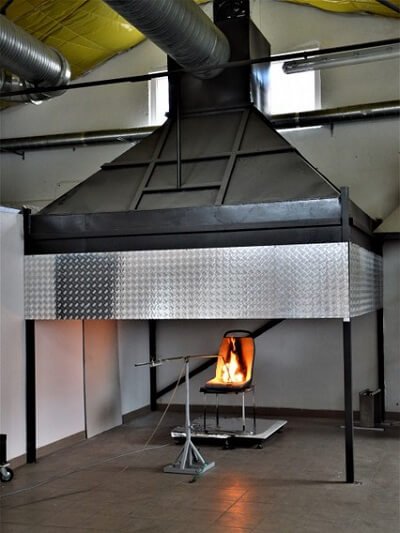EN 16989 Explanation | Railway Vehicle Seat Fire Test
EN 16989:2018 & EN 45545-2:2020
In EN 45545-2:2013+A1:2015 Annex A & B, introduces the complete seat fire test, testing three groups of damaged seats but not considering the case of undamaged seats. It was found that the seats that met EN 45545-2 HL3 only individually met BS 6853 Class Ia, leading to the adoption of different test regimes and producing diametrically opposed test results. Also, in most cases, the test results for the damaged seats were worse than those for the undamaged seats, but there were also times when the undamaged seats had worse combustion performance than the damaged seats.
For this reasons, the CEN/TC 256 railway committee redrafted the test method for the fire behavior test of completed seats to provide detailed provisions for the fire test of complete seats, with various amendments and additions to the fire source, vandalization, test mode, sample requirements, sample arrangement, test procedure and equipment calibration verification procedures and requirements, etc., and was approved in February 2018, officially published as EN 16989:2018 in June 2018.
Seat Requirements in EN 45545-2
In EN 45545-2: 2020, the previous content of the complete seat fire test in Annex A & B are removed, and the test method officially refers to EN 16989: 2018.
Furthermore, EN 45545-2:2020 has certain requirements for complete passenger seats and its materials:
For Non-upholstered seats, there are two principles to meet requirements.
All surface material shall meet the requirement of R6, i.e. seat, front and back of backrest, armrests, etc.
Alternatively, the seat & the back of the backrest materials shall meet the requirements of R6. The front of the backrest, armrest, and removable headrest shall meet the requirements of R21. The complete seat shall meet the requirements of R18.
EN 45545-2 R6 Requirements
| Test Method | Parameter | HL1 | HL2 | HL3 |
|---|---|---|---|---|
| ISO 5660-1 (50kW/m2) |
MARHE, kW | Max. 90 | Max. 90 | Max. 90 |
| ISO 5659-2 (50kW/m2) |
Ds(4), dimensionless | Max. 600 | Max. 300 | Max. 150 |
| ISO 5659-2 (50kW/m2) |
VOF4, min | Max. 1200 | Max. 600 | Max. 300 |
| EN 17084 M1 (50kW/m2) |
CITg, dimensionless | Max. 1.2 | Max. 0.9 | Max. 0.75 |
EN 45545-2 R18 Requirements
| Test Method | Parameter | HL1 | HL2 | HL3 |
|---|---|---|---|---|
| EN 16989 | MARHE, kW | Max. 80 | Max. 55 | Max. 25 |
| EN 16989 | TSP600, m2 | - | - | 45 |
| EN 16989 | Flame Height, mm | 75 | 50 | 50 |
EN 45545-2 R21 Requirements
| Test Method | Parameter | HL1 | HL2 | HL3 |
|---|---|---|---|---|
| ISO 5660-1 (25kW/m2) |
MARHE, kW | Max. 75 | Max. 50 | Max. 50 |
| ISO 5659-2 (25kW/m2) |
Ds max, dimensionless | Max. 300 | Max. 300 | Max. 200 |
| EN 17084 M1 (25kW/m2) |
CITg, dimensionless | Max. 1.2 | Max. 0.9 | Max. 0.75 |
For upholstered seats:
The complete seats shall meet the requirements of R18, test method refers to EN 16989: 2018. Additionally, the seat shall be conducted with cutting vandalization test before the burning test. After cutting vandalization, the length of the cut is measured to assess its level of vandalization.
The seat upholstery, headrest and armrest materials shall meet the requirements of R21.
The seat shell material shall meet the requirements of R6.
EN 16989 Fire Test for Vehicle Seat
Fire Tests with seats can be vandalized
Four fire tests are required if the seat is to be tested fully or partially vandalized.
Two fire tests shall be undertaken with the seat in a vandalized condition.
Two fire tests shall be undertaken with the seat in an unvandalized condition.
Fire Tests with seats cannot be vandalized
Two fire tests shall be undertaken according to Clause 7 with the seat in an unvandalized condition
EN 16989 Fire Test Procedure
Test seat conditioning.
Test seat cutting vandalization.
Test seat positioning under the smoke hood.
Burner positioning on the test seat.
EN 16989 instrumentation and equipment stabilization, exhaust flow shall be 1.2 m3/s.
Start of the data acquisition system.
Burner ignition and flame application, the open flame output of 15kw, application time from 180s~360s from the start of the test start.
Test continuous till 1560s.
Heat release rate (HRR), MARHE, total smoke production (TSP), maximum flame height are calculated and recorded during the test and as the results to assess the performance.
Check the EN 16989 Test Equipment.
Contact us to learn more about the EN 16989 test and instrument.
Email: sales@motistech.com

